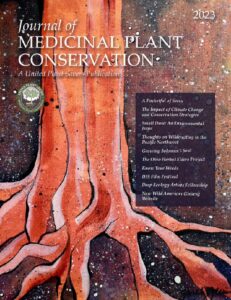Overall At-Risk Score: 66
Latin Name:
Cypripedium spp.; a genus of about 58 species, about 14 of which are native to the United States.
C. acaule, C. arietinum, C. californium, C. candidum, C. fasciculatum, C. guttatum, C. kentuckiense, C. montanum, C. parviflorum, C. passerinum, C. reginae, and C. yatabeanum are all of the non-hybrid native Cypripedium species in the U.S.
Common Name:
Lady’s Slipper; Nerve root, Moccasin Flower, American Valerian
Family:
Orchidaceae (Orchid family)
Lifespan:
Perennial; most species have short growing seasons before dying back
Reproduction:
A single lady’s slipper’s seed pod will contain anywhere between ten and twenty thousand small seeds. Adapted for wind dispersal, their dust-like seeds are remarkably light, and unlike most other seeds, do not contain their own endosperm. The endosperm is the nutrient source most seeds have to aid in germination, so without it, the lady’s slipper relies on fungi in the soil to move into new roots and serve as a food source for the plant, in a relationship known as mycorrhiza.
Geographic Region:
Found in parts of every U.S. state, except for Florida, Hawaii, and Nevada and every Canadian province and territory, this genus is a very diverse and widespread group of plants.
Habitat:
Found most often living among conifer trees, these plants require acidic soil that is rich in fungal activity, moss, and decomposing plant matter.
Vulnerability of Habitat/Changes of Habitat Quality and Availability:
Being a woodland species that often takes decades to establish a population, urban sprawl and deforestation are major threats to these plants.
Ability to Withstand Disturbance and Overharvest:
The particular habitat requirements combined with the long time between seeding and germination of wild lady’s slippers make overharvest and disturbance a major threat to the wellbeing of wild populations.
Status of Endangered/Threatened (by state):
Many of the species under Cypripedium are endangered, threatened, or declining in most of their native ranges; of special note are the following:
(Please note that in cases where the list of states giving a species a particular legal status exceeds three, just the number of states will be listed.)
- C. acaule is “Unusual” in Georgia, “Exploitably Vulnerable” in New York, and “Endangered” in Illinois and Tennessee.
- C. arietinum is of “Special Concern” in Connecticut, “Threatened” in four states, and “Endangered” in Maine and New Hampshire.
- C. candidum is “Threatened” in Illinois, Michigan, and Wisconsin, “Rare” in Indiana, “Endangered” in 5 states, and fully extirpated in Pennsylvania.
- C. kentuckiense is of “Special Concern” in Kentucky and “Endangered” in Tennessee.
- C. parviflorum, the most widespread of the orchids found in the U.S., is endangered in 5 states, is of “Special Concern” in Connecticut, and “Threatened” in Kentucky.
- C. reginae is threatened in 4 states, endangered in 7 more, and fully extirpated in Maryland.
Part of Plant Used/Active Medicinal Compounds:
Lady’s Slipper Orchid roots were used historically to treat issues with the genitals, including menstrual pain, STIs, and urinary pain. It was also used to treat stomach pain and kidney troubles.
Recommendations for Industrial and Home Use:
Though difficult to produce on a large scale in a wild setting, many growers have had luck cultivating Cypripedium species and hybrids in sterile mediums, like agar gel. Cultivated varieties are a viable option to prevent the harvest of wild populations for decorative use, and the sought-after sedative effects of Cypripedium root extract can be substituted with more common herbs like Valerian (Valeriana officinalis). Other alternatives include Lemon Balm (Melissa officinalis) and Skullcap (Scutellaria lateriflora) which have antispasmodic, nervine, sedative, and anodyne actions.
Citations:
- Bergeron, Chantal; Gafner, Stefan; Clausen, Edgar; Carrier, Danielle J. (2005). Scutellaria lateriflora Using Accelerated Solvent Extraction and Supercritical Fluid Extraction versus Standard Hot Water or 70% Ethanol Extraction. J. Agric. Food Chem. 53 (8): 3076–3080. doi:10.1021/jf048408t.
- Black, Meredith Jean, 1980, Algonquin Ethnobotany: An Interpretation of Aboriginal Adaptation in South Western Quebec, Ottawa. National Museums of Canada. Mercury Series Number 65, page 143.
- Hamel, Paul B. and Mary U. Chiltoskey, (1975), Cherokee Plants and Their Uses — A 400 Year History, Sylva, N.C. Herald Publishing Co., page 42.
- Raymond, Marcel., (1945), Notes Ethnobotaniques Sur Les Tete-De-Boule De Manouan, Contributions de l’Institut botanique l’Universite de Montreal 55:113-134, page 128.
- USDA. (n.d.). Plants Profile for Cypripedium (lady’s slipper). Results compiled from multiple publications. Retrieved July 21, 2019, from https://plants.usda.gov/core/profile?symbol=CYPRI
- USDA; U.S. Forest Service. (n.d.). The Lady’s Slipper Orchids. Results compiled from multiple publications. Retrieved July 21, 2019, from https://www.fs.fed.us/wildflowers/beauty/cypripedium/index.shtml

Lady Slipper Podcast 1 – The Plant Detective by Flora Delaterre
Lady Slipper Podcast 2 – The Plant Detective by Flora Delaterre
Related Posts
A Snapshot of the Shakers as Herb Traders by Steven Foster
In tribute to Steven Foster, we would like to share a piece that he wrote on the Shaker medicinal plant trade for the Journal of …
How We Protect Trillium
by Susan Leopold, PhD The adoption of trillium (Trillium spp.) by Mountain Rose Herbs is wonderfully symbolic of the power of the triad found in …








